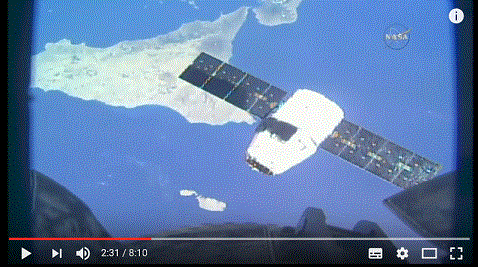|
Elon Musk is planning unmanned XpaceS missions to planet Mars by 2018 and manned trips a little later, say 2024!
"Almost everything Musk does ends up being funded by the government, from his cars to his ambitious battery factory and SpaceX itself."
So what is the SpaceX company? Nobody really knows. Is 100% owned by Elon Musk and Elon controls everything. It is in fact a joke. Everything is fake! I have asked Elon how to go to Mars. No reply.
Early February 2018 Musk tested his latest monster rocket with boosters and it looked like this. Plenty of white smoke for a few seconds at take off ... and then no smoke. Note how two his boosters landed side by side after the launch. The rocket itself went all the way to Mars we were told.
The double boosters landings were 100% fake. They never took place. It was a pre-made, CGI Hollywood show.
SpaceX/Elon Musk say they alone controls nearly 65 percent of the total global commercial launch market. But it is fake news based on false, invented data. Most of the SpaceX launches are 100% fake. Like the Musk Tesla car factory that soon will be bankrupt unless funded by NASA.
The Elon Musk, aka Lone Skum, 2015/6 fake rocket shows/failures are here.
|
Busy Lone Skum has 2017/8 recovered 12 Falcon 9 rockets according to table right. The only evidence is videos; the rocket takes off, after a while the second stage separates and goes into orbit with the payload, while the first stage returns and lands on a barge or where it started a little earlier. |
|
Every video is a pre-recorded show ... including 60 seconds bla, bla intro about XpaceS, then the hypersonic steering flaps are brought out in almost vacuum space to steer the booster/rocket to landing, there is a little rain hitting the camera when going through clouds just before touch down and a final hick-up at the landing, where often the camera facing the bottom of the rocket does not work, etc. Suddenly the rocket has - magically - landed! In the background people are cheering! It is easy to grasp that all landing videos are fake. Some of them are further analyzed by me below to better explain the Elon Musk fraud or hoax for you. Watch the videos and have a laugh!
One of Elon's 100% fake, space trip (CRS-12) - unmanned - started on 14 August 2017, at 16:31 UTC (12:31 EDT), when a false SpaceX's Falcon 9 rocket was launched from Launch Complex 39A (LC-39A) at NASA's Kennedy Space centre in Florida ... watched by people on beach nearby ... we are told.
This was SpaceX's twelfth Commercial Resupply Services mission (CRS-12); the fake Dragon spacecraft carrying over 6.400 lbs of supplies and payloads to the 100% fake International Fake Station at a cost of say $64 million or $ 10 000/lb. The hoax enables NASA to keep XpaceS financially alive. Actually no rocket at all took off. All was video fakery! NASA just pays XpaceS for ... nothing.
|
Following stage separation a couple of minutes later, the first stage of the SpaceX's Falcon 9 rocket succeeded to land at SpaceX's Landing Zone 1 (LZ-1) at Cape Canaveral Air Force Station, Florida. View the video! Now and then there are flashes - rocket engines flash - and the first stage drops vertically down to Earth. See below for details of this impossible, false stunt! The fake SpaceX Dragon cargo spacecraft was later captured with the fake International Space Station's robotic Canadarm2 on 16 August 2017, at 10:52 UTC (06:52 EDT), i.e. about 42 hours later having orbited Earth about 28 times. A little earlier the fake Dragon passed over Sicily and Malta (right) just below the ISS and you can see for yourself that the CGI is getting sloppy. |
|
Elon Musk/XpaceS had earlier sent, in front of large audiences, up his nine-engines Falcon 9 rocket in space, where it disappears behind the clouds (as seen on TV). e.g. the July 18, 2016 XpaceS-9/CRS-9 Launch and Landing Attempt. It is headlines fake news! After a few minutes the 24 tons rocket comes back again from space and lands on Earth after a boost-back burn, an entry burn and a final landing burn. If you need 60+ tons fuel for these three magic burns (at right locations, times, durations and directions) and 140+ tons extra fuel to get the 60+ tons fuel up into space, you should wonder why not use a much smaller three engines rocket and much less fuel to carry a 5 tons pay load into space? Why carry 200 tons extra fuel into space to land the 24 tons nine engines rocket in order to just launch a 5 tons satellite with a smaller three engines rocket? And forget about the recovery!
All is 100% fakery - the Falcon 9 rocket, the launch, the Dragon capsule, the separation, the Falcon 9 first stage rocket landing, the Dragon 9 docking with the fake ISS (and the later un-docking and landing of the capsule) and the ridiculous recovery. The whole show is pre-recorded CGI. Cheap actors explain the technicalities. What a stupid joke. The XpaceS reusable launch system development program is a fairly old, magic trick stunt starting 2012/3 supported by MSM. We are told then ... many years ago:
"In order to make the Falcon 9 reusable and return to the launch site, extra propellant and landing gear must be carried on the first stage, requiring around a 30 percent reduction of the maximum payload to orbit in comparison with the expendable Falcon 9.
The maximum payload is say 8.3 - 22.8 tons and a 30% reduction is then 3-7 tons. The extra landing gear has mass 3 tons! Does it mean only 4 tons extra propellant or fuel is carried to recover the first stage rocket? Of course not. You need >50 times more fuel to recover/reland the rocket ... if you can get it off the ground. XpaceS just invents things and lets MSM trumpet it as truth since many years.
The first stage rocket has nine engines, we are told, which are recovered afterwards! However, it seems that a rocket with only three engines could do the same job ... without being recovered. If it could get off the ground.
When the rocket has disappeared in the sky Elon Musk/XpaceS can invent anything about it, e.g. it delivered some satellites in space or docked with the ISS, while the first stage of the rocket returned and landed again on Earth ... as seen on TV and by large, cheering, noisy audiences. Hollywood will produce the footage of it or Elon does it in-house ... prior to the show. Elon Musk's XpaceS has already (November 2015) won a $2.6bn contract with NASA to send false humans and fake supplies more than 40 times to the fake International Space Station, IFS, so the latter show was just to confirm the earlier one.
More about the XpaceS hoaxes below. You cannot do a re-entry from the IFS. You cannot calculate the trajectory prior of the re-entry and find the location where to start it, and you cannot calculate the trajectory later! But it is very easy to produce fake footage of it to fool the public.
One other recent XpaceS hoax was 8 April 2016 when XpaceS on behalf of NASA launched a ridiculous, fake Bigelow Expandable Activity Module into space, so it could be connected to the fake International Space Station, while the used rocket was recovered intact on a fake barge at sea! It was one of the first successful, fake rocket recoveries on a barge in history by XpaceS!
All 100% fakery of course! Imagine a fake helicopter or drone filming the fake rocket landing live on fake TV in the middle of a fake nowhere at sea. The video is pre-recorded, 100% CGI with a sudden close up of a two seconds touch down on the deck added and funny smoke pasted in to cover the hitches. The un-manned drone barge is rolling and pitching in the waves but the rocket remains steady and vertical! I get sea sick just watching. The barge with rocket later arrives in port where the public can admire the rocket (a stage property!) ... from a distance.
It looks like that 2016 Bigelow Aerospace is also joining the fake and boring NASA/XpaceS space magic show! Media do not really report the fakery rubbish any longer.
XpaceS recovers its first stage nine engines booster rocket something as shown below (there are many - impossible - variations) after having separated from the second stage:
The first stage after separation flies almost horizontally at 130 000 m altitude and 1 480 m/s speed.
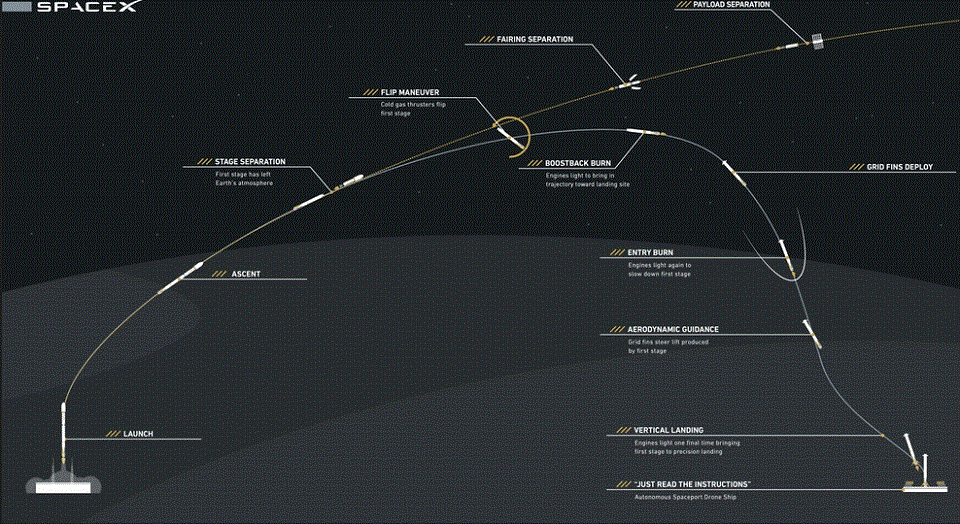
The boost back burn - after a 180° flip - lasts about 30 seconds at that altitude and reduces horizontal velocity from about 1.480 to 330 m/s forgetting influence of Earth gravity. Then vertical velocity increases again due to gravity free fall.
Konstantin E. Tsiolkovsky has established that the change in velocity, delta-v, of a spacecraft in vacuum space (no influence of gravity of adjacent planet Earth) is a function of the mass ratio (spacecraft mass before, m0 and after, m1 firing the rocket engine, difference m0 - m1 being the fuel mass ejected as exhaust gas and the exhaust velocity ve of gas leaving the spaceship rocket nozzle. The actual acceleration or delta-v vector would be found by adding thrust per mass on to the Earth's gravity vector acting on the space craft.Delta-v = ve ln (m0/m1)
Example - here we want to slow down a Falcon 9 first stage booster rocket (with fuel) before entering the atmosphere backwards at an almost horizontal speed of 1.480 m/s (no influence of gravity) to 330 m/s to ensure arriving at the re-entry location. The fuel aboard is ejected at a velocity ve of say 4.000 m/s. Delta-v is then 1.150 m/s!
Then ln(m0/m1) = 0.2875 and m0/m1 is about 1.333!
If the total mass before the boost back burn was, say, 75 tons the mass afterwards was 56 tons and 19 tons fuel was used for the horizontal boost back burn. It is suggested that hypersonic grid fins are deployed in space to steer the rocket ... but there is no air to steer in.
The entry burn also last about 30 seconds between 50 000 and 25 000 m altitude and reduces vertical velocity from 1 300 to 360 m/s again forgetting influence of Earth gravity followed by a second free fall ... but at constant speed (sic)!
How much fuel was used for the entry burn? Now some hypersonic fins come into action by friction but gravity is pulling the rocket down so the fuel consumed must be at least another 19 tons. The mass of the rocket before the landing burn is then 37 tons.
The landing burn also last about 30 seconds and starts at about 5 400 m altitude and reduces vertical velocity from 360 to 0 m/s of course forgetting influence of Earth gravity, when the booster touches down on the barge at 0 speed. Imagine to slow down from speed of sound to 0 in 30 seconds.
Say that you need another 14 tons of fuel for it. Then the mass of the empty of fuel first stage is 23 tons, which is about what Elon reports. It would appear that you need about 52 tons of fuel to stop the first stage rocket and land on the barge.
But that 52 tons of fuel must be carried into space by the first stage rocket in the first place, which really reduces pay load. Question is then how much extra fuel is required for that? Is it about 140 tons?
Say that a Falcon 9 rocket has total mass about 460 tons, most of it fuel, of course, at launch. Say that the second stage with fuel and 5 tons payload has mass 50 tons, thus 45 tons of fuel is needed to go into orbit. The payload stays in orbit and the second stage burns up at re-entry.
It means that the first stage with fuel and nine engines has mass 410 tons. If the first stage mass without fuel is 23 tons and you need 52 tons of fuel for re-entry/landing as estimated above, you use 335 tons of fuel - and nine (!) engines - to accelerate and lift 125 tons of first/second stages with fuel/payload to 130 000 m altitude and >1.480 m/s upward speed. It is pretty good. But 41.6% of the total fuel burnt or 140 tons is used to bring the 52 tons of fuel into space required for landing the first stage again.
So 192 tons of 335 tons fuel used by the first stage to get going - or >57% - is used just to recover the first stage. It doesn't sound right.
A half as big first stage - with only three engines - could easily have brought the 50 tons second stage + payload into orbit.
Why send a three times as big rocket - a Falcon 9 with nine engines - into space just to recover the first stage, when a rocket with only three engines could do the basic job to put the 5 tons payload into orbit?
Why carry/burn 140 tons of extra fuel to recover the three times bigger first stage, when a smaller, lighter rocket with only three engines can do it using half the fuel? Answer is that all XpaceS launches are false! There is therefore little about it on the Internet.
|
Lars Blackmore (pp 17-20 - right) has written about Autonomous Precision Landing of Space Rockets and their dispersions (LOL) and XpaceS refers to him as some sort of expert! All 18 references of the article are pure pseudoscience fiction (see below). It is very easy to demonstrate that Elon Musk and XpaceS faked their four booster rocket landings 2016 - the CRS 8, the Jason 3, the SES-9 and the Jcsat 14 to gain notoriety! Each landing takes about six minutes after separation from 2nd stage. Every time after separation there is a continued forward/upward motion of the booster and a 180° flip of it to enable a 30 seconds almost horizontal three engines boost back burn (to stop horizontal displacement of the booster at high altitude), followed by a free fall drop and a 30 seconds almost vertical three engine entry burn (to reduce speed by about 1 000 m/s), another free fall drop (at constant speed (?) - air drag/friction!) and then, finally, a 30 seconds one engine landing burn, when vertical velocity was reduced from 360 m/s faster than sound speed to 0 in 30 seconds for a soft touch down - brake distance 5 400 meters! |
|
Imagine that - going faster than sound and stop in 30 seconds, i.e. applying a force 12 N/kg for exactly 30 seconds, and stop exactly on the deck. Impossible! So the cameras always stop just before and after landing.
The trajectory cannot be predicted and to steer by autopilot requires soft- and hardware that are not available. An object flying faster than the sound cannot stop in 30 seconds by applying a force - in the exact direction for the exact duration - to it. The 5.400 meters final trajectory cannot be established, so how can you land 'hole-in-one' or 'bull-eye'? Something looking like a rocket is later shown on a barge in port. But it is just a stage property to impress the general public and create the magic illusion that XpaceS is fantastic.
Here are propaganda videos of the CRS 10 start and CRS 10 landing 19 February 2017 taken from a helicopter or drone. The landing is pure CGI.
It shouldn't be too difficult for XpaceS to provide a print out the following data every second during the 360 seconds (or whatever) recovery trajectory of the first stages as shown above, if the recoveries were real:
time (s)
mass (kg) altitude (m) speed (m/s) direction re vertical down (°) horizontal distance to landing site (m) rocket fuel in the tanks (kg) dispersions rocket force (N) applied steering flaps actions Weather (wind, direction, etc)
But no such data can be published. It will give the hoaxes away!
30 March 2017 Lone Skum was at it again. SES-10! Watch the stupid video! Note that at separation the speed is >2 200 m/s at 65.000 m altitude (time 21.36 in the video) and the first stage is still moving upwards, but, when it goes flat/horizontal, we can see the round horizon of the Earth in the background (time 25.00). It seems you are very high up!
There is no boost-back burn to slow down the horizontal speed vector, but it would appear that the first stage is starting dropping down towards Earth then. Then there is a 20 seconds entry burn (time 25.30-25.50), when passing 50 000 m altitude to slow down vertical motion a little for a touchdown at time 28.20 in the video.
So the 50 000 m vertical descent took about 150 seconds after the end of the entry burn, i.e. average speed 333 m/s or the speed of sound. Assuming constant braking the vertical speed was 666 m/s at time 25.50 and altitude 50 000 m (dropping down from say 73 000 m altitude). Just dropping from 50 000 m would increase the speed 100's of m/s.
We don't know the duration of
the landing burn, but at time 28.20
in the video the rocket (or whatever) is suddenly
standing on the barge. 30 seconds before
touch down the speed may have been 133 m/s
at 2 000 m altitude. How the rocket with
mass 23 tons managed to slow down from
665 m/s vertical speed to 0 in 150
seconds is difficult to understand, even if
there was a 30 seconds late landing/brake burn.
Imagine if the vertical speed was 133 m/s
30 seconds before touchdown and you
misjudged the altitude by 2 000 m. You would
hit the barge at high speed. I assume the whole rocket,
launch, landing, video, noisy control room are
show! Time Altitude (m) Speed (m/s) 25.50 50 000 666 26.20 32 000 533 26.50 18 000 400 27.20 8 000 267 27.50 2 000 133 28.20 0 0
Below are some clips of the video:
Three minutes 45 seconds and three minutes 16 seconds
before touch down on the barge the rocket is still up in
space with the bottom facing the round horizon of Earth
below. The hypersonic steering flaps are out.
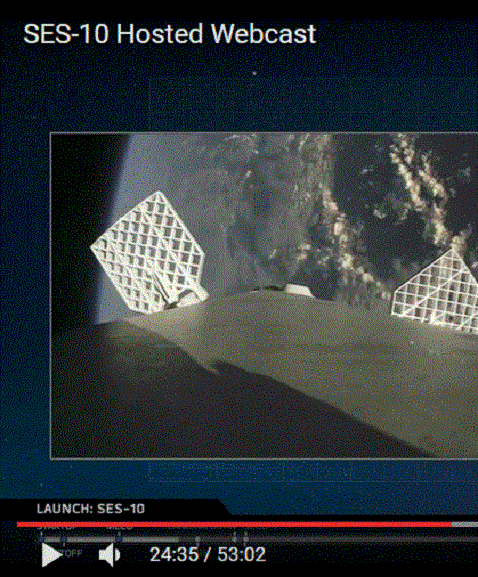

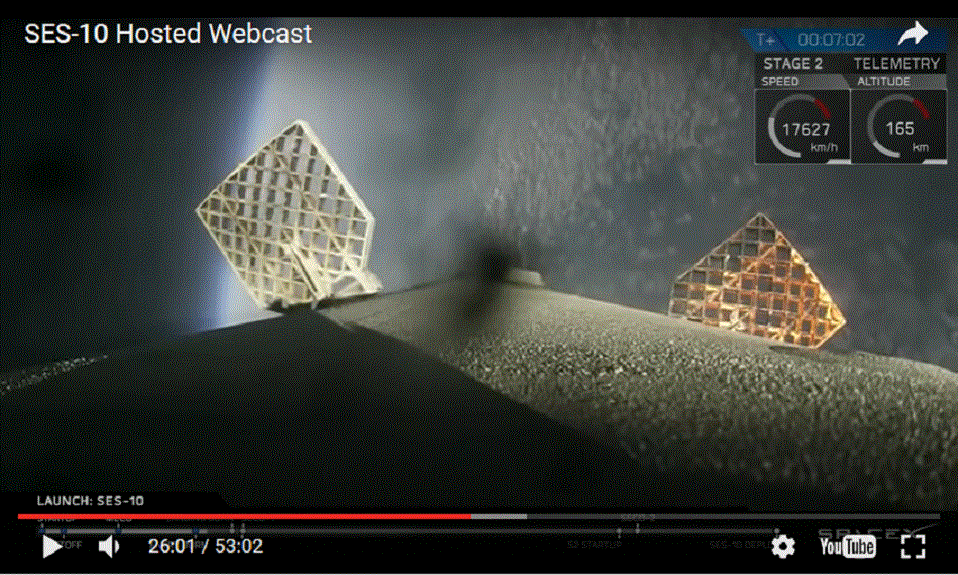
Two minutes 19 seconds before touch down the rocket is still high up in space with the bottom facing the round horizon of Earth below. The rocket must be pretty high up! The barge below is not visible.
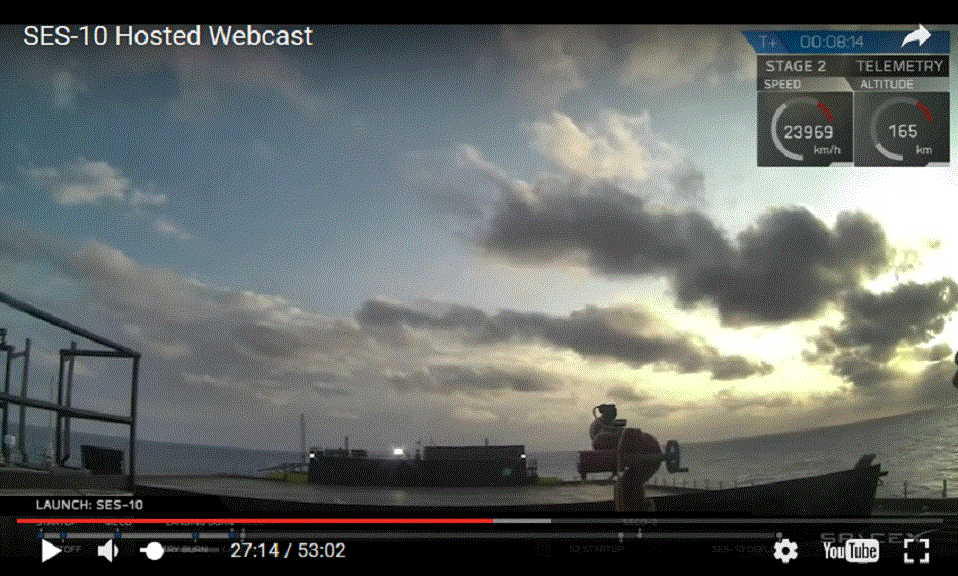
One minute 6 seconds before touch down the deck of the barge is empty. Then there is a communications black out and ...
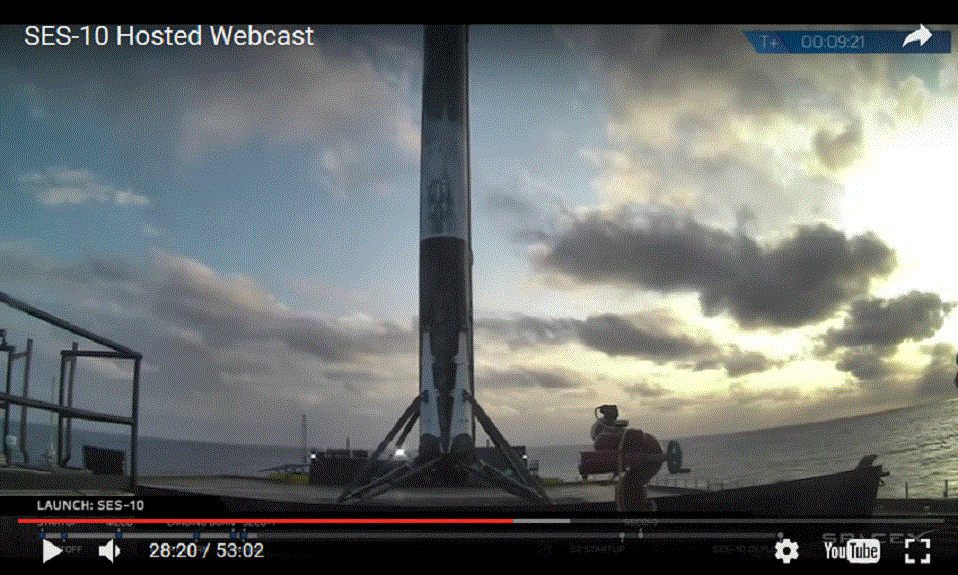
... 66 seconds later the rocket has landed. But maybe it is just a rocket glued in on the previous picture?
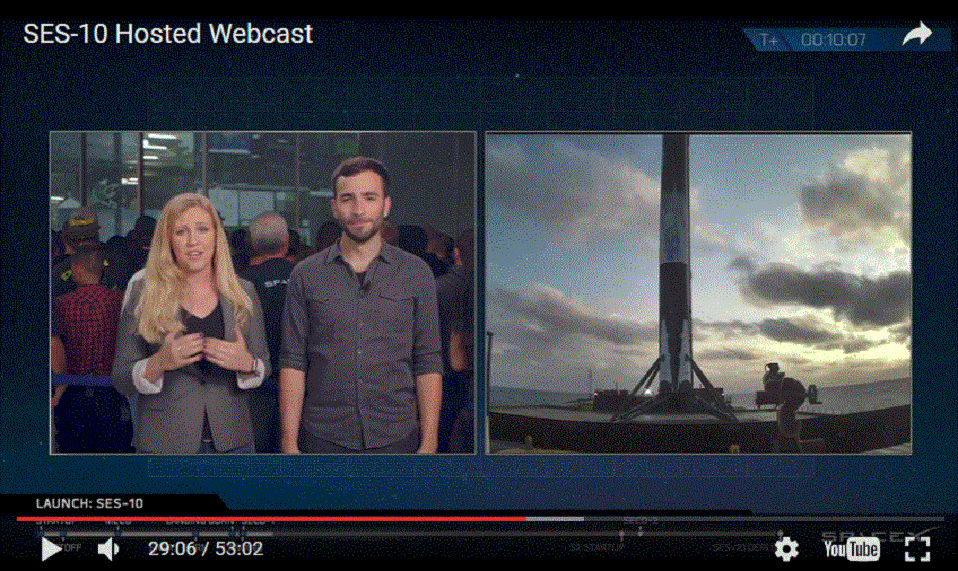
What a show!
I always like comparisons! A simple, expendable Arianespace Vega rocket - total mass 137 tons - easily puts 1.45 tons payload into orbit. The heavier, also expendable Arianespace Ariane 5 rocket - total mass 777 tons - has payload 6.1-16.0 tons. Most of the mass, >90%, is of course fuel and the amount of fuel used is proportionate to payload. Expendable means that the rocket, after all fuel is burnt and the payload is delivered into orbit, drops back into atmosphere and burns up. To suggest - like XpaceS does - that it can launch a rocket and recover a 23 tons first stage, nine engines rocket without extra fuel carried along is simply ridiculous. Therefore every Elon M rocket recovery is a hoax.
Elon Musk is also owner of the fakery Texla electric auto comedy financed by fake NASA. The cars are sold by mail order and, if you later have a complaint, Elon himself will twitter that it is bogus! Elon says he has July 2016 325 000 orders of his new Model 3. It costs $35 000:- and can be ordered against a down payment of $1000:- today. But delivery is not until 2021 ... or ever. Texla will also build trucks and minibuses. All dreams and fantasies. Tesla hasn't made a profit since start. It is a born loser.
The Texla company is therefore also joining the nuclear bomb and power plant scare hoax! Elon's latest trick is to suggest that French, perfectly safe, nuclear power plants on the Rhine are closed down and replaced by his car or battery factories. French top politicians support him. The French are afraid of radiation. Better close everything peacefully safe nuclear, while promoting the A-bomb! It is really STUPID! Why can't MSM report correctly? Elon is a fraud!
How long will it last?
I wonder/write/update this 1
January 2018. Media is not interested.
They support the Elon/Texla
hoax! What can I do? I just watched Elon's latest
show!
I just laugh about it. And here you can see it
going up in the setting sun December
2017! Some idiot says he filmed at
Phoenix, AZ!
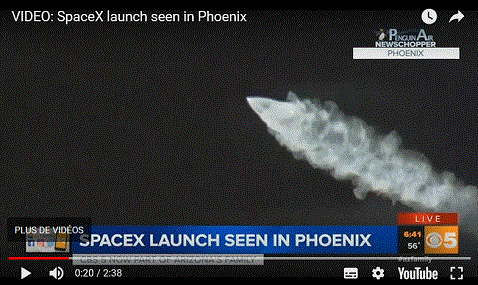
US National
Academy of Science The US National Academy of
Science and Lars
Blackmore
make PR for all this nonsense: 1. Açikmese B, Ploen SR. 2007. Convex
programming approach to powered descent guidance
for Mars landing. Journal of Guidance, Control, and Dynamics
30(5):1353-1366. 2. Bibring J-P, Rosenbauer H, Boehnhardt H,
Ulamec S, Biele J, Espinasse S, Feuerbacher B,
Gaudon P, Hemmerich P, Kletz-kine P, and 9
others. 2007. The Rosetta Lander ("Philae")
investigations. Space Science Reviews 128(1-
4):205-220. 3. Blackmore L, Açikmese B, Scharf DP.
2010. Minimum landing error powered descent
guidance for Mars landing using convex
optimization. Journal
of Guidance, Control, and Dynamics
33(4):1161-1171. 4. Bonfiglio EP, Adams D, Craig L, Spencer D,
Arvidson R, Heet T. 2011. Landing-site dispersion analysis and
statistical assessment for the Mars Phoenix
lander. Journal of Spacecraft and Rockets
48(5):784-797. 5. Golombek M, Cook RA, Economou T, Folkner
WM, Haldemann AFC, Kallemeyn PH, Knudsen JM,
Manning RM, Moore HJ, Parker TJ, and 4 others.
1997. Overview of the Mars Pathfinder mission
and assessment of landing site predictions.
Science 278(5344):1743-1748. 6. Henderson M, Blume W. 2015. Deep Impact : A review of the world's
pioneering hypervelocity impact mission.
Procedia Engineering
103(2015):165-172. 7. Johnson A, Willson R, Cheng Y, Goguen J,
Leger C, San Martin M, Matthies L. 2007. Design
through operation of an image-based velocity
estimation system for Mars landing.
The International Journal of Computer Vision
74:319-341. 8. Johnson AE, Cheng Y, Montgomery JF, Trawny
N, Tweddle B, Zheng JX. 2015. Real-time terrain relative navigation test
results from a relevant environment for Mars
landing. AIAA Guidance, Navigation, and Control
Conference (AIAA 2015-0851), January 5-9,
Kissimmee, FL. 9. Launius RD, Jenkins DR. 2012. Coming Home: Reentry and Recovery from
Space. NASA Aeronautics Book Series.
Washington. 10. Mattingley J, Boyd S.2012. CVXGEN: A code generator for embedded
convex optimization. Optimization and Engineering
13(1):1-27. 11. Meditch JS. 1964. On the problem of optimal thrust
programming for a lunar soft landing. IEEE Transactions on Automatic Control
9(4):477- 484. 12. Prakash R, Burkhart D, Chen A, Comeaux K,
Guernsey C, Kipp D, Lorenzoni L, Mendeck G,
Powell R, Rivellini T, and 3 others. 2008. Mars science laboratory entry, descent,
and landing system overview. Proceedings of the IEEE Aerospace Conference,
March 1-8, Big Sky, MT. 13. Soffen GA, Snyder CW. 1976. First Viking mission to Mars. Science 193:759-766. 14. Squyres SW. 2005. Roving Mars: Spirit, Opportunity, and the
Exploration of the Red Planet. New York: Hyperion. 15. Tomasko MG, Buchhauser D, Bushroe M,
Dafoe LE, Doose LR, Eibl A, Fellows C, Farlane
EM, Prout GM, Pringle MJ. 2002. The Descent Imager/Spectral Radiometer
(DISR) experiment on the Huygens entry probe of
Titan. Space Science Reviews
104(1/2):467-549. 16. Tibbits B, Ivanov M. 2015. Low density supersonic decelerator flight
dynamics test-1 flight design and
targeting. 23rd AIAA Aerodynamic Decelerator Systems
Technology Conference (AIAA 2015-2152), March
30-April 2, Daytona Beach. 17. Way D, Powell R, Chen A, Steltzner A, San
Martin M, Burkhart D, Mendeck G. 2006. Mars science laboratory entry, descent,
and landing system. 2006 IEEE Aerospace Conference, March 4 -11,
Big Sky, MT. 18. Wolf AA, Açikmese B, Cheng Y,
Casoliva J, Carson JM, Ivanov MC. 2011. Toward improved landing precision on Mars.
IEEE Aerospace Conference, March 5-12, Big
Sky, MT.
Very funny references to explain the
XpaceS automatic rocket landings on
Earth. It seems they are all fantasies put
together by JPL over the years and dumped into
journals that nobody reads.
If you find anything wrong with my A B C D E above please tell me at anders.bjorkman@wanadoo.fr !
Below follows my original report available since 2010 and updated all the time thanks to comments by the readers:

